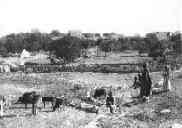- Ephraim
- Shiloh
 The tribe of Ephraim descends from the second son of Joseph and Osnat, the daughter of the priest of On, who was born in the Land of Egypt. According to Genesis 41:52, Joseph named him Ephraim because “god has caused me to be fruitful (hiphrani elohim אלוהים היפרני ) in the land of my affliction”. At the time of Joshua, when the tribes of Israel were allotted their own sections of the Land of Canaan, Ephraim acquired the territory in between western Menasheh in the north, and Benjamin in the south. Unlike the other tribes, Ephraim and Menasheh were descended from Joseph and as such, shared many of the cities between them. The following cities were definitely in Ephraim’s territory: Atarot, Atarot Adar, Bet Horon Ilit, Gezer, Naarat, Taanat Shiloh, Tapuah, and Yenohah. Of these cities, only Gezer fell behind, what is today known as, the “green line”.
The tribe of Ephraim descends from the second son of Joseph and Osnat, the daughter of the priest of On, who was born in the Land of Egypt. According to Genesis 41:52, Joseph named him Ephraim because “god has caused me to be fruitful (hiphrani elohim אלוהים היפרני ) in the land of my affliction”. At the time of Joshua, when the tribes of Israel were allotted their own sections of the Land of Canaan, Ephraim acquired the territory in between western Menasheh in the north, and Benjamin in the south. Unlike the other tribes, Ephraim and Menasheh were descended from Joseph and as such, shared many of the cities between them. The following cities were definitely in Ephraim’s territory: Atarot, Atarot Adar, Bet Horon Ilit, Gezer, Naarat, Taanat Shiloh, Tapuah, and Yenohah. Of these cities, only Gezer fell behind, what is today known as, the “green line”. ---SHILOH
City of Ephraim. According to Joshua 18:1, the tabernacle was set up at Shiloh, which subsequently became the religious center for all Israel. From here, the land was allotted to the Israelite tribes (Joshua 18:8), and during the autumn festival, the women were carried off by the Benjaminites. During the time of the Judges, there was war between Israel and the Philistines resulting in Israel’s defeat and the taking of the Ark at Shiloh by the Philistines. As the Ark was not taken back to Shiloh when it was recovered, and as the sons of Eli officiated in the sanctuary of Nob in the reign of Saul, it may be assumed that the sanctuary of Shiloh was destroyed during the war. In later accounts, the town is mentioned as the home of the prophet Ahijah (I Kings 11:29).
Jews still lived at Shiloh up until the time of Ashturi Farhi in the 14th century. After the Arabs conquered Israel in 636, Arab settlers migrated to the area of Shiloh, established a settlement, and named it “Seilun”. In the settlement, they built a mosque which they called “es-Sekineh” where the memory of Jacob's and Joseph's deeds were revered. Jews began to return to the area beginning in 1974 under the leadership of the Gush Emunim movement. But it wasn’t until January 1978, that a modern community was established, adjacent to the ancient biblical site now called Tel Shilo. In 1979 the Israeli government officially authorized Shiloh's status as a recognized village. It is today administrated by the Mateh Binyamin Regional Council.

No comments:
Post a Comment